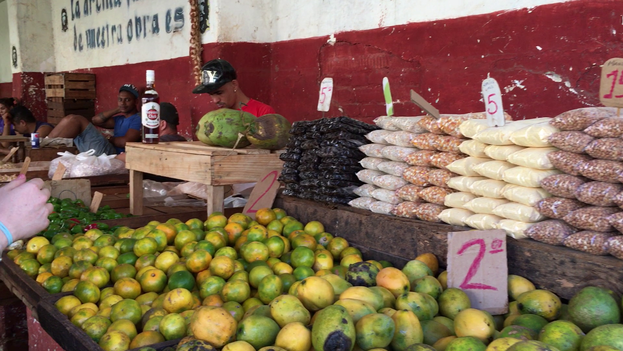
![]() 14ymedio Marcelo Hernandez, Havana, 18 July 2017 — “Everything smells like rotten mango,” says Pascual Rojas, who lives on the outskirts of Manuel Tames, a Guantanamo municipality where part of the mango harvest has been lost, leaving a total of 2,600 metric tons of rotten fruit in recent weeks.
14ymedio Marcelo Hernandez, Havana, 18 July 2017 — “Everything smells like rotten mango,” says Pascual Rojas, who lives on the outskirts of Manuel Tames, a Guantanamo municipality where part of the mango harvest has been lost, leaving a total of 2,600 metric tons of rotten fruit in recent weeks.
“The rains of May and June were already announcing what was coming to us,” explains this peasant born among the furrows and pigsties. “For years we haven’t seen anything like this, where the bushes yield so much fruit,” but “it all turns into flies and garbage,” he complains.
In the deep countryside, where the farmers know how to interpret the signs of each plant and animal, the groves filled with mango trees were a source of worry to more than one. “I told my brother that it would be very difficult to get all that fruit to the people,” recalls Rojas, who considers what has happened to be a “crime.”
“This is a area where there are different varieties of mango, but the mameyson, manga and bizcochuelo are much harvested,” with the latter being very popular for its sweetness and immortalized in the traditional songbook. “All that sweetness has become bitterness,” complains Rojas, who has seen how “mountains of mangos became black and filled with bugs.”
The rainfall of recent weeks has been a boon to Cuban agriculture, experiencing its worst drought in more than a century. Farmers in the area also managed to keep the pests such as anthracnose – a fungal disease – under control. And they have worked to ameliorate the aging of the plantations, but the faltering state framework was again not up to par.
The largest losses are found in the mango crops of the credit and service cooperatives in areas near Bayate (Popular Council of El Salvador) and Manuel Tames, which could not efficiently process the crops with the state-run canning industry .
More than a third of the 6,794 metric tons of mango that were contracted for with producers in the area ended up being spoiled during the month of June, according to a Ramón Sánchez Ocaña, a fruit specialist at the Provincial Delegation Of Agriculture, speaking to the local newspaper Venceremos.
The official explained that the factory located in San Antonio del Sur started operations 20 days after the planned date. The other plant, located in El Guaso, was also working at half of its capacity because of a shortage of cans in which to pack the pulp. To the technical problems was added the inefficiency of the state service in charge of haulage and collection.
“We had many problems with transportation and truck breakdowns,” an employee of the Acopio Provincial Transportation Base in Guantanamo, who requested anonymity, told 14ymedio. The problems were mainly due to “breakdowns and complications in fuel supply,” he says.
“We took a big hit on boxes, because if we don’t have them we can’t bring the mangos to the factory in good shape,” he adds. He blames the several factors that joined together to cause the disaster on the “bad organization” of the state company.
This opinion is shared by Manuel, a farmer living in the vicinity of the Ángel Bouza Credit and Services Cooperative, one of the most affected by the losses. “Here the pigs have had to eat mangos morning noon and night, because there is nothing else we can do with so many mangos,” he says.
“Even the children, instead of throwing stones, were throwing mangos because they became worthless when we realized that they would not be able to transport all these boxes from here,” he explains. “This happens every year, and this time the television came to film it and then shared it with the National Assembly, but it is nothing new,” laments the farmer.
Little is said about the producers’ losses. “There are people here who are thousands of pesos in debt because they had put a lot of money into this harvest,” adds Manuel. “My brother-in-law lost more than 5,000 pesos with all this and who is going to pay back that money now?”
During the last session of Parliament the heavy losses reported provoked criticism among the deputies and annoyance among the consumers in the agricultural markets who saw the news on the national media.
“In Havana I have to pay between 3 and 5 CUP (Cuban pesos) for a medium mango, but in the East they are rotting without anyone being able to eat them,” complains Clara Carvajal, 71. The images transmitted on the national television “are pitiful,” she adds.
On the island the mango has a seasonal consumption cycle, which starts after the rains of May and ends in September. “Mangos are only available for a few months and nevertheless the State gives itself the luxury of leaving them in the fields.”
Far from Guantánamo, in the municipalities of Güira and Alquízar (Artemisa province), where they produce fruits and vegetables for the capital, the situation is also worrying.
“If we don’t do some serious work it will be the same here,” said a farmer with a basket of mangos on a small cart pulled by horses. “This is the year of the lost mangos,” he says while pointing out the branches loaded with tasty fruit that rise along the side of the road.
